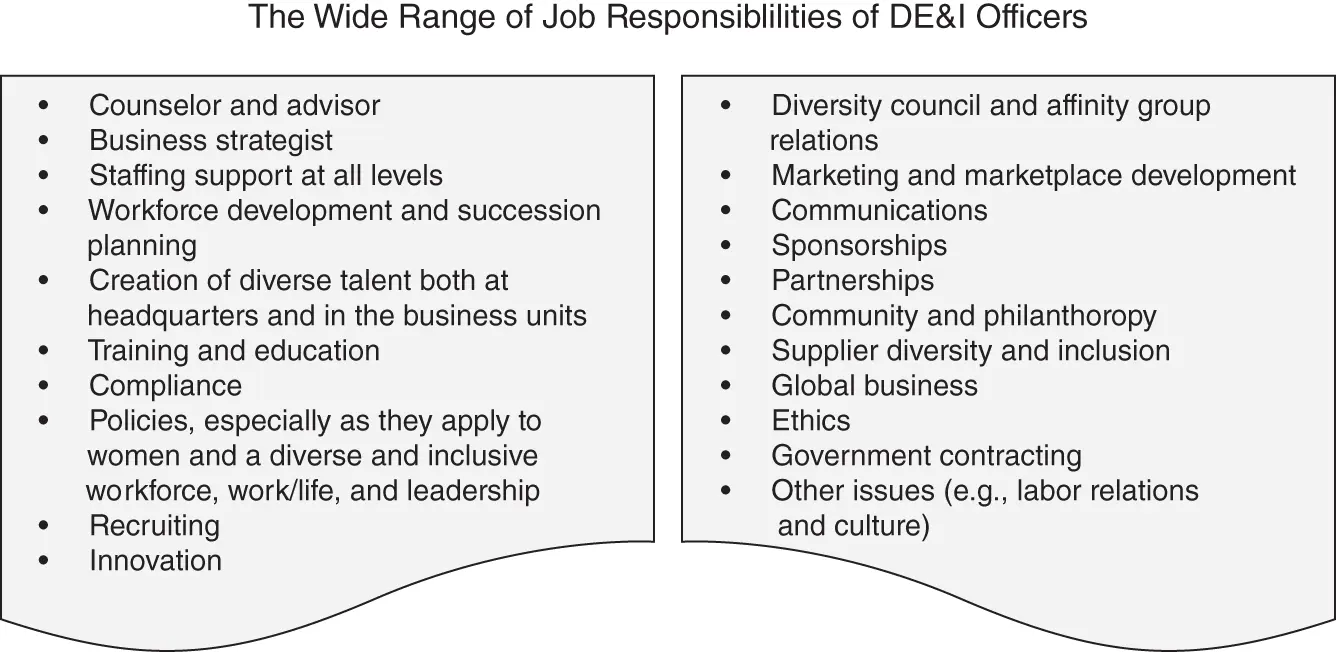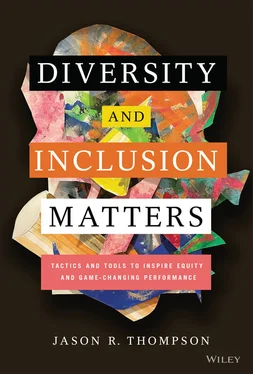Jason R. Thompson - Diversity and Inclusion Matters
Здесь есть возможность читать онлайн «Jason R. Thompson - Diversity and Inclusion Matters» — ознакомительный отрывок электронной книги совершенно бесплатно, а после прочтения отрывка купить полную версию. В некоторых случаях можно слушать аудио, скачать через торрент в формате fb2 и присутствует краткое содержание. Жанр: unrecognised, на английском языке. Описание произведения, (предисловие) а так же отзывы посетителей доступны на портале библиотеки ЛибКат.
- Название:Diversity and Inclusion Matters
- Автор:
- Жанр:
- Год:неизвестен
- ISBN:нет данных
- Рейтинг книги:3 / 5. Голосов: 1
-
Избранное:Добавить в избранное
- Отзывы:
-
Ваша оценка:
- 60
- 1
- 2
- 3
- 4
- 5
Diversity and Inclusion Matters: краткое содержание, описание и аннотация
Предлагаем к чтению аннотацию, описание, краткое содержание или предисловие (зависит от того, что написал сам автор книги «Diversity and Inclusion Matters»). Если вы не нашли необходимую информацию о книге — напишите в комментариях, мы постараемся отыскать её.
Diversity and Inclusion Matters: Tactics and Tools to Inspire Equity and Game-Changing Performance,
Diversity and Inclusion Matters
Diversity and Inclusion Matters — читать онлайн ознакомительный отрывок
Ниже представлен текст книги, разбитый по страницам. Система сохранения места последней прочитанной страницы, позволяет с удобством читать онлайн бесплатно книгу «Diversity and Inclusion Matters», без необходимости каждый раз заново искать на чём Вы остановились. Поставьте закладку, и сможете в любой момент перейти на страницу, на которой закончили чтение.
Интервал:
Закладка:
In 2016, a colleague that was the chief diversity officer at a very large tech company called me and said, “I have a problem, and I need your help. We sent out an email after the presidential election as we knew emotions were running high and people were very concerned about Donald Trump being the president.” My colleague told me that as soon as the email went out, they began receiving emails from African American employees. The employees were questioning why the company had not also sent out an email in support of Black Lives Matter. In exasperation, this particular chief diversity officer said, “I am getting it from all sides. I can't win.”
I could fully appreciate that my colleague felt as though their work were being criticized. Being a chief diversity officer can be very isolating. Many times other executive leaders don't understand this concept and the non-executive employees often have expectations that can't always be met. I did not want to diminish how they were feeling, but I told them, “Your program is working.” The fact that employees were contacting the chief diversity officer meant that they felt empowered to speak up. Inclusion means employees can share their concerns without retribution. It means we can talk openly about sensitive subjects like race, ethnicity, sexual orientation, gender, ability, and many other identities and subjects. Tension is a natural part of those conversations, which is why good DE&I programs have tension.
It is not unusual to see something similar after sexual harassment training. People mistakenly think that sexual harassment training will reduce complaints because employees will stop the harassing behavior. While training can reduce occurrences of harassment, we typically see an increase in complaints after sexual harassment training. Why? Because when sexual harassment training is done correctly, it reduces the behavior of harassment, but more importantly, it signals to employees that they do not have to accept inappropriate behavior and that there is a process to protect and support them.
Effective DE&I programs have ongoing training and policies to limit bias and bad behavior, and they also have clear processes for addressing complaints. In the early stages of a DE&I program, ongoing training is proof of the organization's commitment. Cultures take time to change, so ongoing training is necessary to help employees understand the change and expectations. Once they do, employees working in inclusive cultures will let you know how they think you're doing.
DE&I Officers Need a Broad Range of Skills
Over the years, when I tell people I work in DE&I, I am often asked, “What do you do on a daily basis?” Even people who understand the goal of DE&I don't really know what it looks like in action. My response is that it is like being the producer for an orchestra. In an orchestra, the conductor leads the musicians, but the producer has to find the individuals to play a diverse range of instruments to get the music right. As a DE&I officer, you need to be able to influence each individual employee and understand the organization's music , but you don't get to make the final decisions. That is left to the CEO, who is like the conductor of the company. In that way, DE&I is like any other behind-the-scenes job – and no one notices you until something goes wrong. Problems are inevitable, and in order to be prepared for them, the major skills a DE&I officer will need are influence, relationship building, data analysis, and patience, because the DE&I officer will be called out and put on the hot seat.
Here are some common issues that DE&I professionals have to address:
The leadership team is not diverse. I hear this all the time. I cannot count the times I have heard, “If the company was committed to diversity, the leadership team would be more diverse.” This is true, but drastic change in the diversity of the leadership team will not happen in a short period of time. It doesn't happen quickly because that would require high turnover in leadership positions and high turnover at any level of a company is a bad thing – especially the leadership team. In Chapter 5, I will give you some ways to address this, but for now, I'll leave you with another one of my Jasonisms: One of the biggest challenges for DE&I professionals is unrealistic expectations. The skills you need are data analysis, patience, and the ability to articulate realistic expectations.
There is no diversity on the board. Here again, a significant change in the demographic makeup of the board takes time. A drastic change in any corporate board in a short period of time is typically a bad thing. If you don't believe me, ask the people at General Electric. 5 Their board shake-up was a response to doing poorly, not the result of a high-performing organization. The chief diversity officer (CDO) cannot make decisions about the makeup of the board but is held accountable for its lack of diversity. There have been changes and legal requirements to create more board diversity, but these changes take time and, sometimes, mandates from the government. 6 Again, the skills you need are data analysis, patience, and the ability to help set realistic expectations.
If the company were committed to equity, women would be paid fairly. This is true, but the majority of hiring and salary decisions that created this problem of inequity were made before you started. Additionally, when you bring this to the attention of the organization, the changes to salary won't happen the same day. There are many constraints, real and sometimes political, and the CDO doesn't control all the variables. The skills you will need are relationship building, data analysis, and thick skin. The truth is that no one should have to wait another day to be paid fairly, but it is also not your fault. You do not have the authority to change salaries, but, trust me, you will be held accountable.
The marketing ads look racist. This one happens all the time. Ask the people at H&M, Target, Dolce & Gabbana, or Estee Lauder just to name a few. 7 Here, again, not every ad is given to the CDO for review and approval, but if an ad lands poorly, they will call on you to fix it. The skills you need here are relationship building, writing good apologies, and staying current on events.
African American, Women, Latinx, or fill in the blank employees are not being promoted. There is a long list of companies that struggle in this space “For instance, at Google, only 2.6% of leadership and 2.4% of technical workers are Black. At Facebook, Black people make up only 3.1% of those in leadership roles and 1.5% of those in technical roles.” 8 The lack of promotions is likely an indicator of a deeper problem, and one that has been going on before you started. It may not take that long to diagnose but putting in a solution never moves fast enough, and you will be put on the spot to fix it. The skills you will need are data analytics and relationship building.

Figure 1.2 Job Responsibilities of DE&I Officers.
There is a long and varied list of skills and abilities that a DE&I officer needs. Figure 1.2is a snapshot of things I had to understand and address over my career, and I can assure you that the list here is far from complete.
A day in the life of a DE&I professional is multi-dimensional. Many days I have started my morning with an unconscious bias training, taken meetings to support employees who may be experiencing discrimination, reviewed and edited press releases/social media postings, created an invitation for partnership with an external partner, supported a sales meeting, reviewed/edited a company policy, and ended the day by writing a blog post. In a single day, I've been a trainer, counselor, communications director, strategic partnership manager, salesperson, legal analyst, and writer.
Читать дальшеИнтервал:
Закладка:
Похожие книги на «Diversity and Inclusion Matters»
Представляем Вашему вниманию похожие книги на «Diversity and Inclusion Matters» списком для выбора. Мы отобрали схожую по названию и смыслу литературу в надежде предоставить читателям больше вариантов отыскать новые, интересные, ещё непрочитанные произведения.
Обсуждение, отзывы о книге «Diversity and Inclusion Matters» и просто собственные мнения читателей. Оставьте ваши комментарии, напишите, что Вы думаете о произведении, его смысле или главных героях. Укажите что конкретно понравилось, а что нет, и почему Вы так считаете.











